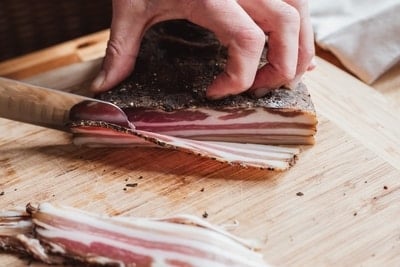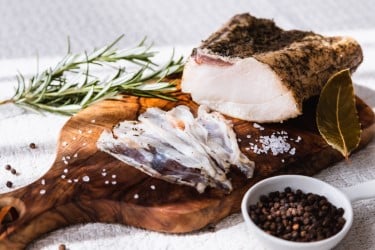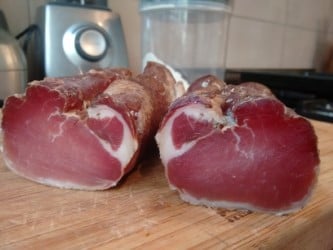Why Make Coppa
Coppa represents a cut of pork muscle that is ideal for dry curing. It’s the upper loin or, more accurately, the collar of the pig used above the front shoulder of the pig.
Many Italian Norcini butchers I’ve talked to believe this muscle group has the ideal 30% fat-to-meat muscle ratio. It looks visually appealing, with streaks and lines in different directions of fat running through a somewhat round shape, and can look a little like dry-cured salami.
The names vary by region. Coppa is used in Northern Italy (Emilia Romagna), and Capocollo or Capicola is more commonly used in Central and Southern Italy.
Regional Differences
In Southern Italy, the meat is often cured with more spices, especially in Calabria, where hot peppers are a prominent ingredient. The process may involve more wine and subtler spice blends in Northern Italy.
I’ve been making coppa for many years. It’s one of my favorite dry-cured whole-muscle meats.
Key Ingredients
To make this recipe as helpful as possible, I’ve created a custom calculator inside the craft recipe below. This will help auto-calculate the salt and spices based on the weight of the meat.
Sea Salt is essential for any curing project. For this style of equilibrium curing, it’s best to make the salt finer (I prefer powdery fine) and distribute it throughout the meat when applying the salt cure.
If you use pink-curing salt (more this below), it’s 90% salt, and nitrates/nitrites comprise the rest. Therefore, if you want a total salt amount of 2.25%
0.25% of this total can be pink-curing salt. This is a specific quantity percentage for using the equilibrium curing method.
Quality of Meat
Quality collar pork muscle — the size and fat of the collar will be very dependent on how well-fed the pig was and the age. Do some research on your meat provider.
This often means the pig must be 12-14 months old. I’ve usually found 24 months ideal for the meat-to-fat ratio (talk to the butcher or do the research!).
Pork Scotch fillet or ribeye is another name for the area of meat from which coppa originates, although the traditional way of knowing the length is 4 to 6 ribs from the front of the pig. This is how the pig is divided into three main groups for half a pig: after head removal, the collar/front leg, belly, and then the back leg (you can see this in the picture a little later on).
The process of dry curing meat intensifies the meat flavor, which is why meat quality is imperative to salt dry curing.
Sugar should not be an ingredient in classic Italian salumi of any kind.
Key Equipment
For this equilibrium salt dry curing method (link to a guide I wrote), an accurate digital scale – a subject covered a lot on this website, here is a page on scales. It’s nearly imperative (or another form of accurate scale allowing precise measurements of one decimal place per gram).
Having an adequate-sized bag for the meat during curing is vital. The air is to be removed inside the bag. I use Ziploc bags, or water bath/sous vide bags for this task. The goal is to have the meat and cure “equalizing” inside the bag.
How to make Coppa
If it needs to be trimmed first after the curing stage begins, it can take 1 to 2 weeks.
After curing, the drying and hanging stage applies until sufficient moisture and weight loss have occurred.
Curing Stage
Step 1
Depending on the shape of the neck/collar, you may need to shape and trim it. The traditional shape is oval. Some casings can make the shape more round and uniform with typing.
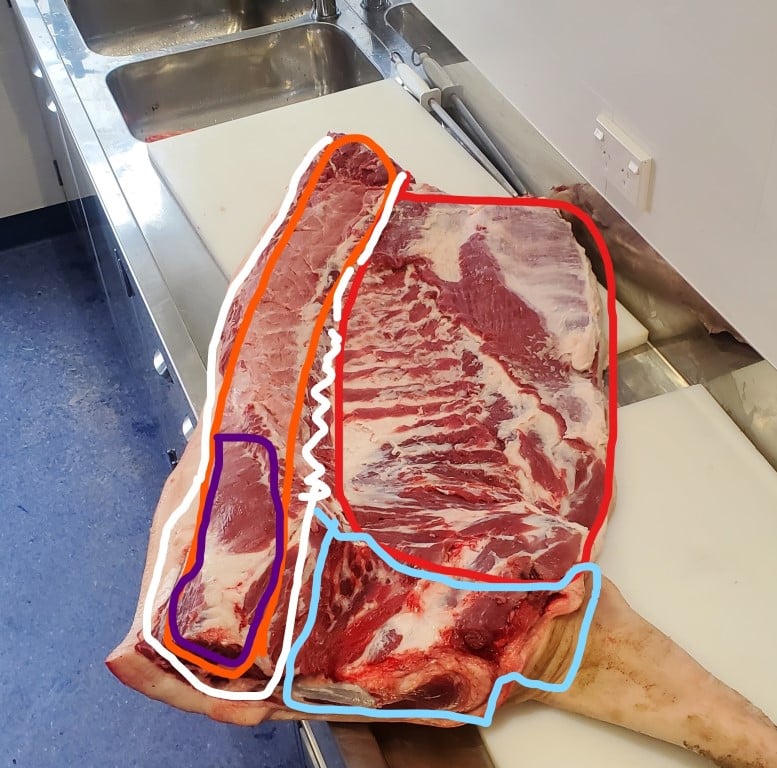
Step 2
Weighing the collar meat first for the equilibrium curing method, you can also record the minimum 30% weight loss needed for the drying process below.
If using nitrates/nitrites, accurately calculate the required pink-curing salt No. 2 (optional). No.2 Pink Curing is for meat-curing projects over 30 days long.

Step 3
Use a mortar and pestle or spice grinder to make the salt cure mixture finer; if it is coarse, this will help spread the mixture evenly across the meat.
Ensure there are no lumps to spice clusters in the cure mixture.

Step 5
Mix the salt cure mixture and apply it to the meat in a bowl or lipped metal tray. Then, place the meat and all the cure mixture from the bowl into a bag.
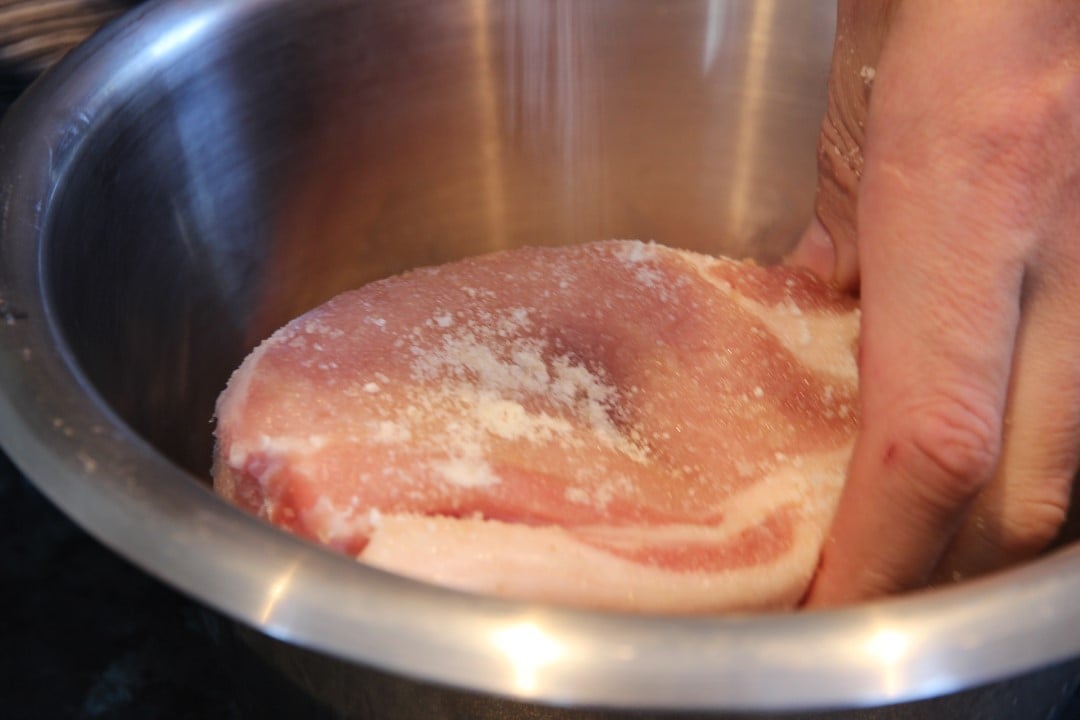
Step 6
Remove the air from the vac pac or ziplock bag; the goal is to have minimal air in the bag during curing.
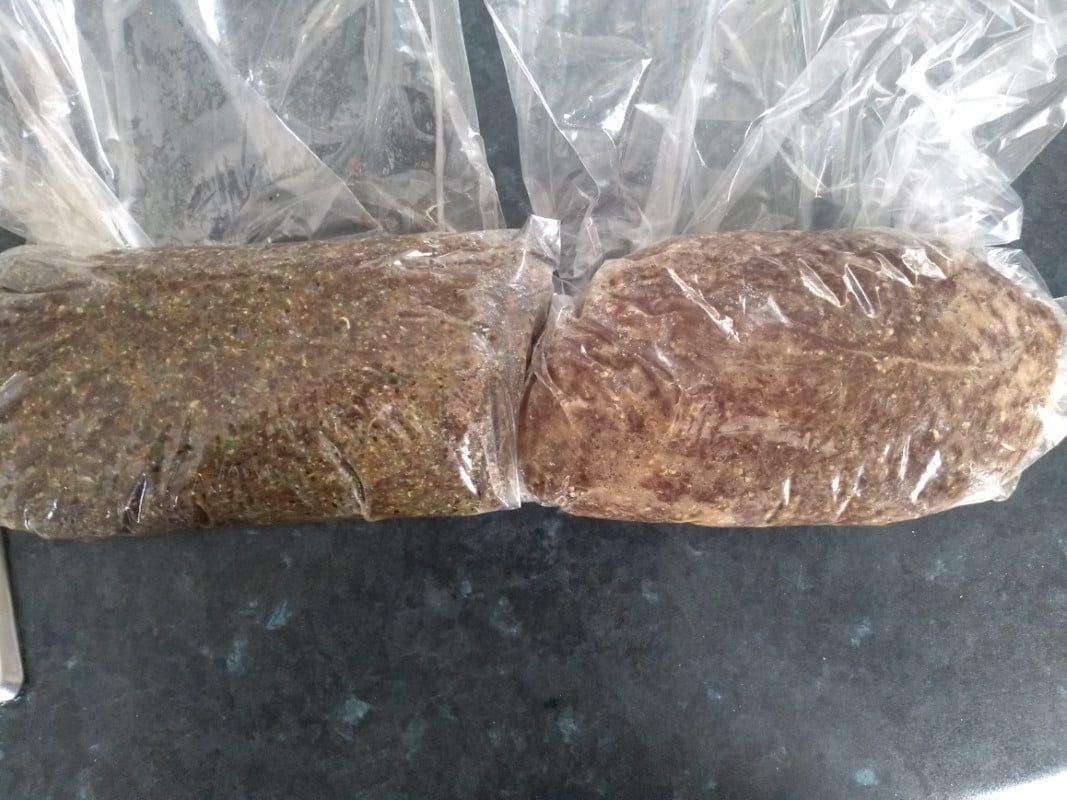
Step 7
Cure in a fridge or cool area at 2-6°C or 35-45°F
Imperial – 3 Days per Inch Thickness of Meat
Metric – 3 Days per 25mm Thickness of Meat
The advantage of using equilibrium curing, you can have the meat curing for an extra week or two. This will not increase the saltiness of the meat because it equalizes the salt content throughout the meat.

Drying Stage
Step 8
Once fully cured, remove the bag.
(If you forgot, weigh the meat and calculate % of the weight; this is a minimum weight loss for the finished product after hanging/drying.)
To hang the meat, you can tie butchers twine like the picture below. then a S hook or butcher twine can be used to hang onto a rod or rack. A chopstick can be used as per the picture also
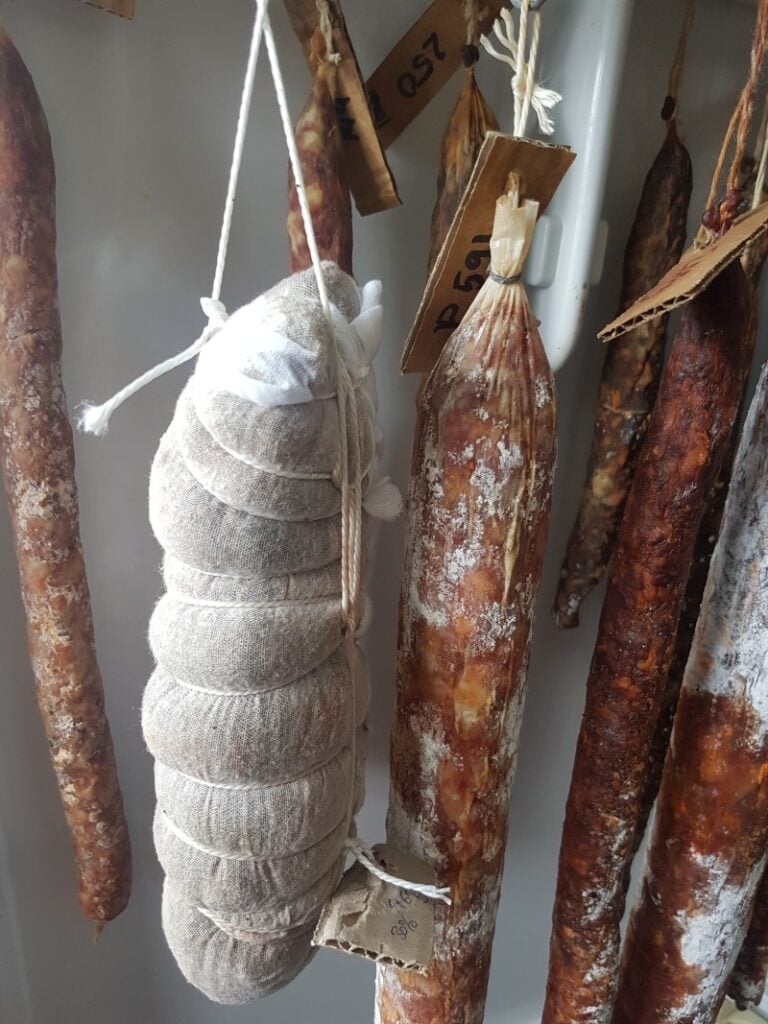
Hang the cured meat in a suitable environment. This could be a wine cellar, garage, shed, DIY dry curing chamber, commercial dry curing chamber, or other suitable environment
The conditions should be in this range approximately:
| Temperature | Humidity |
| 50-61°F/10-16°C | 65-80% |
You will need to check the meat regularly while it is drying. The reason for these conditions is to slowly dry the meat without drying the outside before the inside loses moisture (often called ‘case hardening’).
Airflow will also vary the speed of drying. A small amount of airflow is desirable, and ‘fresh’ air or a breeze is often preferred to avoid unwanted mold.
If too much ‘good’ mold forms, you can use vinegar to wipe or brush away the excess. For more on molds, please read this article.
Step 10
Once the weight loss is approximately 30% minimum, the dry cured meat is finished and can be eaten as is, or used for cooking!
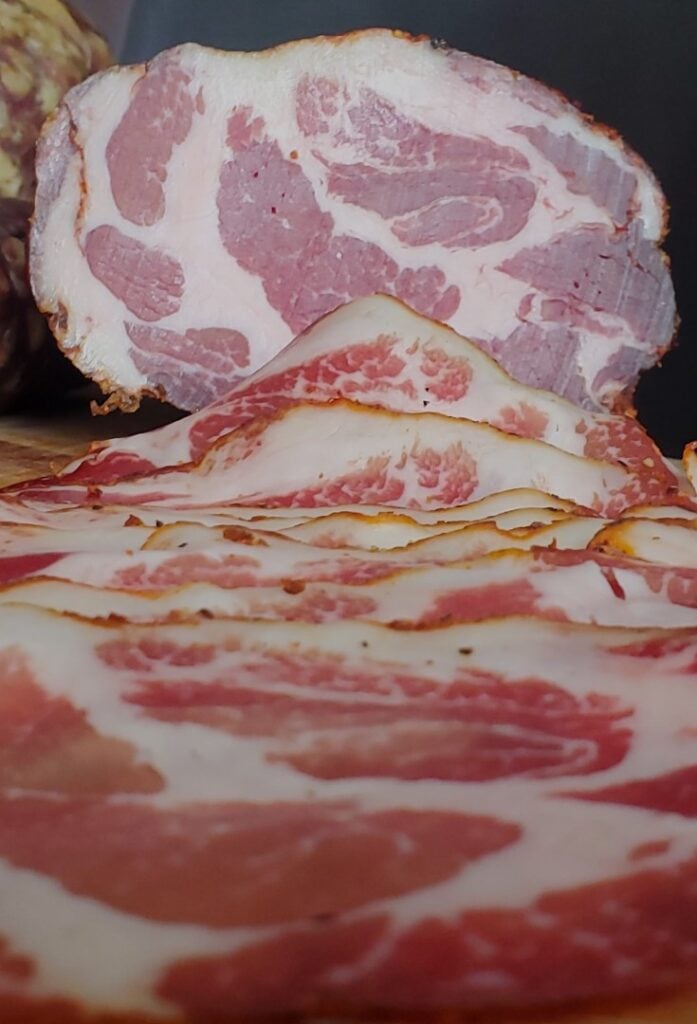
Expert Tips
- Casing options exist for collagen sheets that can be wrapped and tied. The traditional method used an animal bunch of pig/beef bung (salt-cured preserved intestine). Butcher twine was used to squeeze and hold the casing, then prick to avoid air bubbles as well.
- To avoid drying the exterior at the beginning of hanging, a higher humidity of 85% can be used for a few days, then reduced to approximately 70-75%.
- Before tying, a casing over the meat can prevent the outside from drying out as much. Beef bung, pig bung, or collagen sheets can be used for this.
Recipe Variations
You can vary the amount of sea salt to your preference. A minimum of 2.0% salt is needed for curing. My salt level is often 2.25% total.
The maximum I prefer for saltiness in dry-cured whole muscle is 3.0%.
What & How to Serve
- Slice wafer-thin and add to antipasti board as a starter/appetizer.
- As part of a charcuterie board, it’s often the favorite amongst guests.
Frequently Asked Questions
Difference Between Coppa and Coppicola?
In Northern Italy, Coppa is mainly used as the name for this dry cured meat. Capocollo or Capicola are used more in Central and Southern Italy.
What is Coppa Cured Meat?
Coppa is salt-dry-cured whole-muscle meat. It’s preserved with salt and dried to be shelf-stable. Subtle spices, such as cinnamon, cloves, and nutmeg, are used. Coppa is served by slicing very thin.
Storing and Shelf Life
The environment is cool, approximately 50-60°F/10-15°C. The finished cured meat can be hung around the kitchen. It’s preserved, so you can thinly slice it for serving when desired.
Placing it unwrapped in the fridge will speed up the drying. Most domestic fridges have a humidity of 20-40%.
Vacuum-packing and storing it in the fridge can be used for several years. I’ve had dry-cured meats in vac-packed bags in my fridge for three years.
More Craft Recipes You’ll Enjoy
What to Expect for Serving Size
Since dry cured meat often loses 30% of its weight, it’s a more condensed form of protein. Dry-cured salumi, like this, were never produced to be eaten as a primary protein for a meal.
It’s a craft creation to be savored in small amounts. Twenty to fifty grams is plenty per person as a starter.
Scaling the Craft Recipe
You will see below the recipe has an auto-calculating recipe based on the input of the meat weight.
This will allow you to calculate the salt cure mixture. If you wish to adjust the calculation below you can also use a meat curing calculator I created on this page.
Coppa – Dry Cured (Equilibrium)
Using quality pork from a well-fed, older animal. The upper-neck of the pig (loin closest to the head, above the shoulder). It's often about 3 to 4 rib-bones from the front, for a decent size cut. Also, it's known as the Scotch fillet or Ribeye (in a similar area). Italian's often belive this is an ideal muscle group, because it has approximately 30% fat and 70% meat.
Ingredients
- 1000 g Upper Pork Loin Muscle
- 22.5 g Salt (2.25% of meat weight)
- 8 g Black pepper (0.8% of meat weight)
- 3 g garlic powder (0.3% of meat weight)
- 3 g cumin (0.3% of meat weight)
- 3 g cloves (0.3% of meat weight)
- 1 g cinammon (0.1% of meat weight)
- 2.5 g Pink Curing Salt No. 2 (Prague Powder #2, Instacure #2, many other names – To be used for over 30 days meat curing projects (0.25% of meat weight) Optional See Notes
Instructions
Curing Steps
-
Weigh the meat accurately, record weight
-
Calculate or Use the Recipe Above to Auto-calculate the Salt and Spices
-
Use a Mortar and Pestle or Spice Grinder to mix the salt and spices. Mix salt, spices, and optional curing agents thoroughly, ensuring even distribution in the cure.
-
In a large bowl or tray rub and cover the meat with the salt and spices (it will seem like not much, but this is enough of the cure)
-
Apply the Cure: Coat the meat with the curing mixture, ensuring all surfaces are covered, including crevices in the meat.
-
Place the meat and all the salt cure mixture into a sealable bag- options include vacuum bags, zip lock bags etc.
-
Remove From Bag
Hanging and Drying Steps
-
Optionally, apply additional spices or aromatics before hanging – ie. chili, peppercorns
-
Hang in a Suitable Environment: Place the meat in a cool, well-ventilated Area, Cellar, Garage, DIY Curing Chamber, Regular Fridge (Small Amounts), Dry Curing Chamber
-
Monitor Progress: Regularly check the meat’s weight and appearance to gauge the curing process’s progression. Vinegar dabbed onto mold can remove it, if excessive growth occurs.
-
Achieve weight loss of a minimum 30%, ideally 35-40%. However, large fat amounts have less water in regards to Weight loss.
Recipe Notes
Please note that the craft of making dry-cured meats is beyond a recipe. This is not a cooked product. It takes a reasonable amount of knowledge to safely create salumi, charcuterie, and salami.
My advice is that if you have doubts about smell or visual cues, it’s not worth eating.
This is my interpretation of a classic salumi whole muscle dry cured meat project.
- Hang the meat in a suitable environment, ensuring proper airflow and humidity levels for optimal drying.
- For small amounts under 300 grams, you can dry the meat on a non-reactive rack in a regular fridge. However, the outcomes will be far from ideal.
- If fuzzy or powdery white mold develops, you must use your senses to assess it. Here is an article about mold in detail.
- Pink Curing salt is an optional ingredient – please carefully read this other article I’ve written about this.
- If you want to build a DIY dry chamber, I’ve written extensively on the topic here.
- Always complete the drying before consumption.
- Uneven drying is always an issue with making dry cured meats after weight loss is complete. Removing the mold with vinegar, leaving it to dry in a regular fridge, and then vacuum packing for 4-8 weeks can equalize the meat moisture evenly.
I’m always interested; if you have questions, please leave a comment below. Look forward to hearing how your project goes!

Tom Mueller
For decades, immersed in studying, working, learning, and teaching the craft of meat curing, sharing the passion and showcasing the world of charcuterie and smoked meat. Read More

